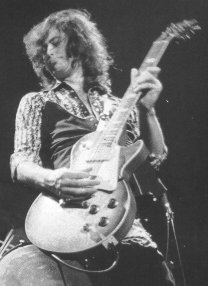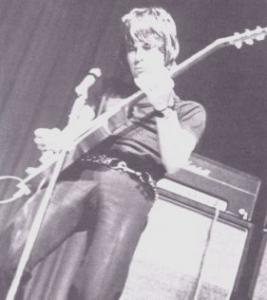 |
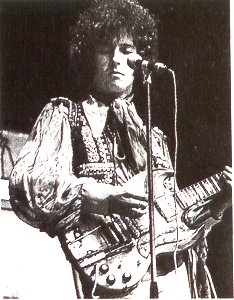 |
| Beck, Clapton, Hendrix, Townshend | |
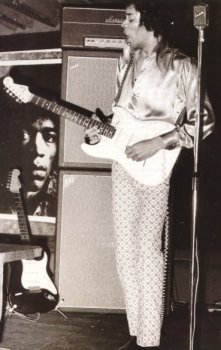 |
|
 |
 |
| Beck, Clapton, Hendrix, Townshend | |
 |
|
By Graeme Pattingale and Jeffrey Aarons
Eric and Jimi - Guitar techniquesJimi Hendrix is one of the greatest electric guitarists. His unique technique, seamless amalgam of several genres and mastery of feedback place him in the pantheon of the guitar giants. An incendiary live presence, voluminous recording sessions, heavy drug intake and an early death enabled the creation of a legend and an industry.
That legend and industry has unfairly overshadowed the innovations of Eric Clapton, Pete Townshend and Jeff Beck. They, especially Eric and Pete, had as profound an effect on Jimi as he had on them.
The Early Hendrix
Jimi had been a backing musician in R&B bands on the "Chittlin' Circuit" (one nighters throughout the States generally playing to black audiences in mainly small venues such as clubs). Jimi had not really established himself as he always became frustrated with the restrictions placed on his playing by the bandleaders. Eventually he formed his own band under various names but principally "Jimmy James and the Blue Flames". For the black audience he was just another guitarist with a very ordinary band - he was competing against Buddy Guy, the Kings (B.B., Freddie, Albert) and many others. He gravitated to the 'white' Greenwich Village where his Blues/R&B pastiche was a novelty and his wild appearance more acceptable. It took British visitors to recognise his potential. After checking out Jimi, at Linda Keith's insistence, Chas Chandler, bass player of the Animals, saw his opportunity to move into management when, to his surprise, he found Jimi was not contracted (not quite correct but that's a long legal story). Chas offered to take Jimi to England and hooked him by guaranteeing he would introduce him to Eric as Jimi had heard the "Bluesbreakers" album. The final form of the new band was to be resolved in England.| Jimi arrived in England on 24th September
1966. Even on the way from the airport Jimi was introduced to one of Britain's finest in
Zoot Money. Auditions for the band began almost immediately with Noel Redding being chosen
on bass by looks alone, as he was actually a guitarist. The drummer was more problematic
and it came down to either Aynsley Dunbar or Mitch Mitchell. When Mitch was auditioned he
was impressed with Jimi's wide ranging repetoire of Blues, R&B and Rock & Roll.
Mitch was not clear what Jimi and Chas wanted to do musically. The name "Jimi Hendrix
Experience" was deliberate in that it could cover any range of formats from trio to a
type of R&B Review. Once selected Mitch, in exasperation, pressed Jimi on how he was
to play ..."like Ginger Baker?". The trio was formed in early October nominally only for a short tour in France. The repertoire was Jimi's Blues/R&B/R&R pastiche. Mitch was not impressed at playing "In the Midnight Hour" again after a steady diet of it in Georgie Fame and The Blue Flames. Noel just did what he was told as he needed the money. Jimi knew, as well as Mitch, that this wasn't the future as they were really competing against Cream and The Who. Those bands contained the leading and most innovative instrumentalists in the UK. At this stage, even the guitarists were technically, but not necessarily in technique, more advanced. |
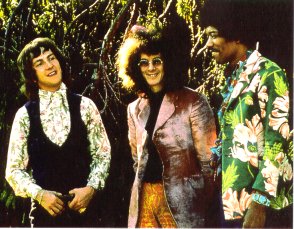 |
Cream and The Who never saw each other as competitors as The Who were R&B/Pop and Cream, the Blues. The same statement applies to the individuals. Cream did however take up the Marshall stacks developed for the Who and Ginger adopted the double drum kit set up that Moony had been using since late ’65. It appears Cream moved to double stacks in 1967 about six months before the Experience but almost two years after the Who.
Sizing up the Competition When not auditioning, Chas took Jimi around to hear the best bands in England. Pete remembers Jimi visiting The Who in the recording studio and discussing amps. Undoubtedly he also checked out Jeff in the Yardbirds, Peter Green in the Bluesbreakers and on 1st October the man himself. Chas arranged with Eric and Jack for Jimi to sit in at the Central Polytechnic. Eric introduced Jimi as "the cat from Seattle" and he launched into Killing Floor. Jack and Ginger were not impressed, as they didn't know the song, which was rhythmically awkward and harmonically complex for a blues. Ginger believed that his guitarist was the best and thought that Jimi was just trying it on (or "taking the piss" as he probably would have described it). Eric was impressed and recognised a very real competitor. I'm sure Jimi appreciated the Marshall Stack as he was rehearsing with 30 watt Burns amps! After literally throwing their Burns gear down stairs and out of the back of vans Jimi and Noel got their Marshalls - another couple of basses sold by Chas. Now Jimi began in earnest to develop his sound. Jimi had been using a fuzz box in the USA but the recognised master in England was Jeff Beck. Jeff had perfected the combining of it with an overdriven Marshall, which, if not done properly, would produce blurry noise. It took some time for Jimi to perfect it and didn't appear on stage until January 1967. The last months of 1966 were spent mastering the Stratocaster/Marshall combination.Eric and Pete got together over a drink in late '66 to discuss life, music and Jimi. They each recognised that he was a potential threat to their reputations but as yet he hadn't much audience impact. They were also annoyed that he kept taking on their ideas. For Pete it got worse as Hendrix appropriated elements of his stage act including windmilling arm, smashing guitars (Germany in Nov '66), assaulting the speaker cabs and use of microphonic feedback.
A New Experience The Experience spent November and December rehearsing, performing and recording under Chas' guidance. By January '67 they were really starting to get it together with some strong originals and reworked covers. Individually they were also getting it together with Jimi getting his sound right, Noel more proficient on bass and Mitch locking with Jimi. On 11th January 1967 they performed at the Bag O'Nails in London. In attendance were the pop music elite of England to check them out. On their way in, Eric and Pete met Jeff on the way out. "That bad, Jeff?" asked Pete, "No, that good" was the reply. Hendrix had really arrived and from now on The Who and Cream would even occasionally appear as support groups to the Experience.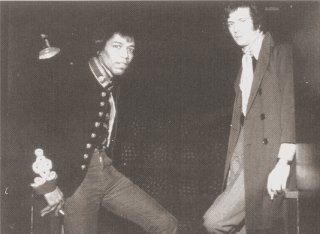 |
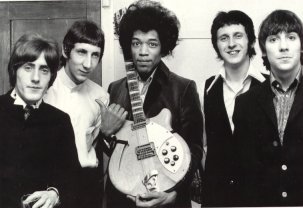 |
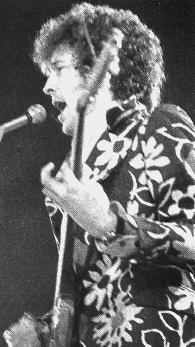 |
The following demo recording session, the
"Lost Session", shows how their thinking and playing was changing. Disreali
Gears took that further with Eric's use of wah wah plus the dominance of the non-blues
songs. After hearing "Tales of Brave Ulysses" Jimi got a wah wah pedal.
Unfortunately for Cream "Disraeli Gears" was not released until November '67 and
had to compete with Jimi's two albums released that year. "Are You Experienced"
is a marginally more sophisticated "Fresh Cream" with Jimi's playing still quite
raw in places. His playing is simply not as well rounded as Eric's on Fresh Cream. As an
album it does have the advantage of a more integrated and focused sound, musical
approach and songwriting, because of the dominant creative individual. The same can be
said of "Axis: Bold As Love" vis-a-vis "Disraeli Gears" but with
Jimi's playing now more refined. The very real innovations of Gears were nullified by a
delayed release. The real difference between Cream and the Experience was a trio of equals and a leader/backing band. Jimi got a fine drummer who instinctively melded, and a bass player who would largely play what Jimi directed. Who decided what was to be played in Cream? They all did with Jack and Ginger hammering each other as they had been doing for years! The Who was also dominated by a single creative individual and their longevity shows the advantage of such a situation in the world of rock and pop. |
Pete's response was to get more physical and louder - the wind milling arms began to be a guitar sound effect as well as theatrical. Also his song writing became more adventurous, Moony got even more manic and the thunderous bass of the Ox held it all together. The three bands were in total competition. Jeff by this stage was into heavy touring of the US with the Yardbirds but his moment of Truth was soon approaching.
To treat Jimi as a total original is misleading. He became a total original but that was after incorporating elements of Eric's and Pete's unique approaches. They in turn took on board what Jimi was doing. In Pete's case to greater theatrics and for Eric a looser less reverential approach to the blues. Neither changed their already well established guitar styles and techniques. It was a process of further refinement/development, not any significant change.
| Beck was also developing a distinctive
approach due to 'competitive forces' rather than borrowing - that was left to Jimmy Page.
1968's "Truth" displayed him in full glory as another original with the
following "Beck-Ola" arguably the first "Heavy Metal" album. . Jeff is
not as technically accomplished as Eric or Jimi, or as extroverted as Pete. He is a somewhat distant second as far as sheer
numbers and examples of derivative technique: finger vibrato, bending style, pick attack,
architecture, specific signature riffs or modes, and finally tonality. He has a distinctive
attack and approach involving neat little "trick" riffs and Les
Paul influenced dynamics, that were almost a throwback to rockabilly but more advanced. Its this, and he was doing it in 1965, that makes him
stand out in terms of originality against the many other hot guitarists of the era.
|
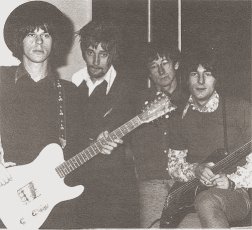 |
Who's the geeza with the goatee? And checkout the hybrid guitar! |
Jeff Beck, Eric Clapton, Jimi Hendrix and Pete Townshend remain the most important guitarists in Rock music. All developments since can largely be sourced to their individual or collective fountainhead. Others have some claim to membership of this group but in the light of serious analysis they don't quite reach that peak of originality. Ironically the least technically accomplished of the four, Pete, has the greatest obvious influence today - the chording lead rather then single note and with the whole spectrum of songwriting and rhythm guitarists, acoustic and electric. And of coarse his amp volume/pyrotechnics and guitar whacking which were components integrated into the other three especially Hendrix.
Townshends' influence is the greatest or most inclusive. However, by comparison, the influence of Clapton and Hendrix have, by far, cultivated and literally defined the very foundation, form and role of modern blues rock guitar playing/soloing. Eric and Jimi - Guitar techniques FEEDBACK: Enter Your Opinions, Read the Feedback Site Contents Since 23rd July 1998
Some WHO stuff:
|
The Who at the Windsor Blues
Festival 30th July 1966. They headlined Saturday, Cream on Sunday.
|
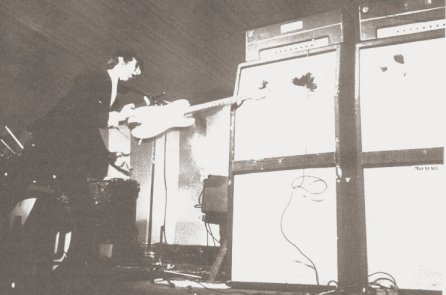 |
|
Customising the Stacks |
|
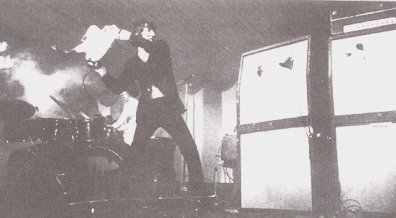 Another guitar (and amp!) demolished
|
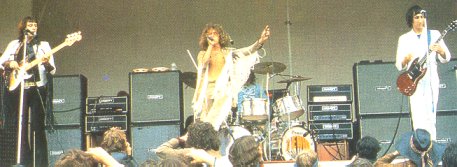 |
Ironically in late '68, after making the Marshall Stack de rigueur in
the Rock world, The Who converted to HiWatt stacks. They also began using a WEM
reinforcement PA which, during '69, they developed into the best touring sound system in
the world.
|
The Masters' Apprentice -
